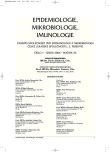Methods for Detection of Biofilm Formation in Routine Microbiological Practice
Možnosti průkazu tvorby biofilmu v rutinní mikrobiologické praxi
Stále častější používání katétrů a umělých implantátů, podávání antibiotik a vysoký počet imunokompromitovaných pacientů patří mezi hlavní příčiny rostoucího významu biofilmových infekcí. Jejich charakteristické rysy, především značná rezistence k antimikrobiálním látkám a tvorba dlouhodobě perzistujících ložisek, komplikují terapii. Proto je pro klinické lékaře znalost přítomnosti tohoto faktoru patogenity cenná a měla by mít vliv na postup při léčbě pacienta. K průkazu schopnosti tvořit biofilm u klinicky významných mikroorganismů je však potřeba dostatečně spolehlivý a citlivý postup, kterého lze použít i v podmínkách běžné mikrobiologické laboratoře. Pro průkaz tohoto faktoru virulence se v současnosti používá široké spektrum vyšetřovacích technik. Vizualizací biofilmu mikroskopickými technikami počínaje přes kultivační průkaz, detekci jeho složek, odhalování fyzikálně-chemických odlišností biofilmpozitivních mikroorganismů ve srovnání s jejich planktonickými formami až po průkaz genů zodpovědných za jeho tvorbu. Vzhledem k omezením jednotlivých metod lze nejlepších výsledků dosáhnout nejlépe jejich vzájemnou kombinací.
Klíčová slova:
biofilm – metody průkazu biofilmu – Christensenova zkumavková metoda – agar s kongo červení – kapilární zónová elektroforéza – kapilární izoelektrická fokusace.
Authors:
F. Růžička; V. Holá; M. Votava
Authors‘ workplace:
Mikrobiologický ústav Lékařské fakulty a Fakultní nemocnice u sv. Anny v Brně
Published in:
Epidemiol. Mikrobiol. Imunol. 55, 2006, č. 1, s. 23-29
Overview
The increasing use of catheters, artificial implants and antimicrobials as well as high numbers of immunocompromised patients are major causes for concern over biofilm infections. These infections are characterized particularly by high resistance to antimicrobials and formation of persistent foci that may complicate therapy. Therefore, detection of biofilm formation is of high relevance to the clinician and his/her approach to the treatment. Reliable and sensitive methods for detection of this pathogenicity factor in clinically important organisms, suitable for use in routine microbiological laboratories, are needed for this purpose. Currently, a wide array of techniques are available for detection of this virulence factor, such as biofilm visualization by microscopy, culture detection, detection of particular components, detection of physical and chemical differences between biofilm-positive organisms and their planktonic forms and detection of genes responsible for biofilm formation. Since each of these methods has limitations, the best results can be achieved by combining different approaches.
Key words:
biofilm – methods for biofilm detection – Christensen’s test tube method – Congo red agar – capillary zone electrophoresis – capillary isoelectric focusing
Labels
Hygiene and epidemiology Medical virology Clinical microbiologyArticle was published in
Epidemiology, Microbiology, Immunology

2006 Issue 1
Most read in this issue
- Methods for Detection of Biofilm Formation in Routine Microbiological Practice
- Comparison of Efficacy of the Rapid Mycobacteria Growth Indicator Tube (MGIT) Culture Method (Manual System) and Conventional Culture Method in Mycobacterial Detection
- Current Prevalence of Toxocariasis and other Intestinal Parasitoses among Dogs in Bratislava
- Current Epidemiological and Clinical Issues Regarding Helicobacter pylori Infection in Childhood
